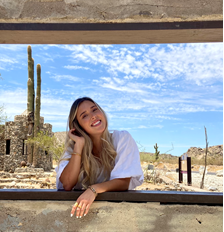Sophomore Soars in AU’s Research Laboratory
 Megan began her undergraduate studies at American University in 2019. A native of Phoenix, AZ, she was eager to experience a new world of opportunities in Washington, DC. But while the east coast may have been uncharted waters for Megan, her declared major was quite familiar territory.
Megan began her undergraduate studies at American University in 2019. A native of Phoenix, AZ, she was eager to experience a new world of opportunities in Washington, DC. But while the east coast may have been uncharted waters for Megan, her declared major was quite familiar territory.
“At a very young age, I knew I wanted to be a doctor,” she says. “My mother was a practicing hepatologist when I was a kid. Science and medicine were always a part of my life, and I aspired to follow in her footsteps.”
At the beginning of her sophomore year, Megan’s academic course load consisted of a few CORE requirements, but mostly prerequisite courses outlined for all biology students. One of these fundamental biology classes was with Dr. Katie DeCicco, chair of the Department of Biology. In the 16-week cell biology lecture and lab, Megan began to connect with Dr. DeCicco. This connection motivated Megan to inquire about the professor’s cancer research lab and her potential of securing a spot on the team in 2021.
“I started gaining interest in research during Dr. DeCicco’s cell biology lectures,” Megan said. “She often mentioned how topics we were learning in class were related to her lab research. My interest in getting more involved grew over the course of the semester. I felt I had nothing to lose by reaching out and seeing if I could get more involved with the lab after winter break.”
Megan’s wish came true. In spring 2021, she joined Dr. DeCicco’s cancer research laboratory. The team is heavily operated by two graduate students, Laura Purkey and Maria Ochiai, both working towards master's degrees in biology. As leaders of the lab, Laura and Maria are responsible for running experiments, allocating responsibilities to undergraduate students, and maintaining an operating rhythm for the lab. Megan, along with six-to-seven undergraduate peers, assists by increasing the number of experiments and supporting the overall efficiency and effectiveness of the lab.
To date, the lab is working on two projects. The first, covering multiple melanoma, spanned the entirety of the spring 2021 semester. “We investigated how obesity influences the risks associated with multiple melanoma cancer,” Megan said. “It was incredibly eye-opening.”
Additionally, the team has started a study on cutaneous squamous cell carcinoma. It is investigating microRNA expression as a molecular variable in cutaneous squamous cell carcinoma, a widely known type of skin cancer. Researchers will specifically identify the unique features of RNA to see how it is expressed differently in this type of skin cancer.
“We are hoping to identify if this cancer worsens as a result of certain mutations in the microRNA,” Megan said. “I go to the lab for about 10 hours a week, typically on Tuesdays and Fridays. My work consists mainly of western blotting and qPCR techniques, but each day looks a little different from the previous one.”
Weekly, the undergraduate students have a lecture/review day with a graduate student(s), where pop quizzes will be informally issued on methods and/or procedures learned throughout the previous week. These lessons are also a time to expose the undergraduates to new or unfamiliar lab techniques, as well as analyze trends in data and synthesize what the data represents. Lastly, Dr. DeCicco hosts a lab meeting each Friday, where she will review progress and ensure students are continuing forward with their research.
Megan summarized it best by saying, “Dr. DeCicco’s lab has taught me crucial lessons, not only about lab techniques and the research process, but more importantly about the value of group collaboration. I think the best way to learn is by learning from both supervisors and peers, and then sharing what you’ve learned with others. I get to do exactly that here. It truly is a group process from start to finish. We all share our successes, our setbacks, and every other learning opportunity in between.”
Megan and her peers are the driving force behind the day-to-day successes seen throughout the laboratory. The field needs to see additional students with a willingness to step outside the box and learn in a more hands-on experience.
“I definitely recommend researching if it fits into your schedule,” Megan said. “Even if you can’t get directly involved, students should talk to their professors about their research. It gives you a different experience, one that is not learned in a classroom or from a textbook. It allows you to connect to your field of interest and apply your curriculum to a real-life situation."
So, how do you plan on creating a hands-on experience in your course of study? If you are like Megan Little, you will start with a dream, build a relationship from the simplest of experiences, remain steadfast in your pursuit of academic excellence, and always stay open-minded to a world of possibilities.